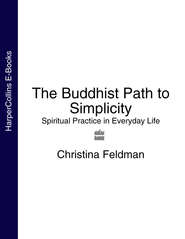По всем вопросам обращайтесь на: info@litportal.ru
(©) 2003-2024.
✖
20 MINUTES TO MASTER … MEDITATION
Автор
Год написания книги
2019
Настройки чтения
Размер шрифта
Высота строк
Поля
NAMING
As you begin your meditation and turn your attention to your breathing process, naming is another means of connecting your attention more closely with your breath. As you breathe, silently make a mental note of ‘in-breath’, as you breathe out silently make a mental note of ‘out-breath’. The words ‘rising’, ‘falling’, ‘expansion’ or ‘contraction’ can be gently attached to each movement.
Continue to note each inhalation and each exhalation as they occur. The purpose of using these labels is to bring the attention closer to the actual experience of each breath as it occurs. Care needs to be taken in using the mental notes so they neither become habitual nor interfere with the direct perception of the breath on a moment to moment level.
The introduction of naming is an effective way of bringing the mind to calmness and one-pointedness, particularly in times when it is particularly agitated or busy. As the mind calms and the attention begins to stabilize the mental notes will fade in significance and drop away.
BARE ATTENTION
After settling yourself in your posture and turning your attention to your breath, again sense in your body the entire movement of your breath from beginning to end.
Notice the slight pause between the ending of one out-breath and the beginning of the next in-breath. Let your attention move in harmony with the movement of each breath, following its progress from your nostrils to your abdomen and the movements of your body as the breath is released.
Notice the sensation of your breath as it enters your body and passes through your throat, the expansion and contraction of your chest and the rise and fall of your abdomen.
When distracted, again simply return your attention to the next breath to begin again.
CONCENTRATION WITH PHRASES
Some schools of meditation will elect to bond particular phrases with each breath as it occurs. The purpose of this bonding is to remind us of the deeper objectives of our practice which is not to become a perfect breather nor just to achieve altered states of experience, but to awaken us and to cultivate the qualities of heart and mind that enable us to live with greater wisdom and compassion. The phrases can vary enormously; some of the frequently used phrases are ones that express particular qualities of heart and mind. As you breathe in you may silently repeat ‘breathing in calmness’, or ‘breathing in peace’ and silently repeat the utterance in harmony with the out-breath. You may choose to harmonize the phrase ‘May I be filled with peace’ or ‘May I be free from fear’ with each breath.
Again there are some fundamental guidelines to be aware of as you use phrases with your breathing. Keep them simple, too many words will make your meditation too conceptual. Use phrases that genuinely express your inner aspirations in meditation, the qualities you are seeking to cultivate or embody. Link your phrase with each breath closely, so they do not become habitual and can be founded upon a true sense of meaningfulness.
MOMENT-TO-MOMENT CONCENTRATION
This practice is focused upon developing a powerful and steady attentiveness which, instead of selecting a subject of meditation that excludes every other phenomenon that arises in the moment, is inclusive. It is a practice of cultivating a wholehearted attentiveness that is directed towards whatever aspect of our experience is most predominant in any moment. It is a fluid attentiveness that can shift between the breath, body sensations, sounds, thoughts, feelings and sights – giving to each moment an attention that is directly and clearly perceiving whatever is taking place.
In this style of moment-to-moment concentration, the breath is frequently adopted as being the central anchor of concentration where the attention rests and the focus it returns to when distracted or unsteady. When the attention is drawn away from the breath to another area of our experience that has become more predominant, such as sensations, sounds or thoughts, it is intentionally directed to that area to know clearly with bare attention whatever is being experienced. Whether the object that the attention is directed towards is a sound or a body sensation is secondary in importance; primary is the cultivation of one-pointedness, clear seeing and calmness.
Sometimes mental noting is attached to this development of bare attention. When the attention is drawn to a sound, the mental note of hearing is brought in; when drawn to a thought the mental note that most appropriately describes the theme of that thought is brought, such as memory, planning, fantasy, etc. When the attention is drawn to a sensation in your body, the mental note of feeling, pain, warmth, etc., is brought. The mental notes need to be used in the spirit of simplicity; they are not a means to evaluate or analyse what is taking place but simply an aid to seeing the movements of the mind more clearly. The various movements and changes within the mind-body process are held in the light of a clear and simple attention – the attention is then returned to the primary anchor point of the breath.
This is a style of concentration meditation which can be cultivated equally in both formal meditation periods and in the midst of our daily activities such as walking, doing the laundry, taking a shower. The attention is increasingly attuned to the present moment and whatever is taking place within it. Nothing is considered to be a distraction, but whatever is occurring in any moment is seen as an invitation to develop a mind of steadiness and clear seeing. It is a path of attentiveness that makes a tangible difference in the quality of our actions and movements as we cultivate wholeheartedness and sensitivity. Every moment of our life becomes an integral part of our meditative path.
Вы ознакомились с фрагментом книги.
Приобретайте полный текст книги у нашего партнера:
Приобретайте полный текст книги у нашего партнера:







